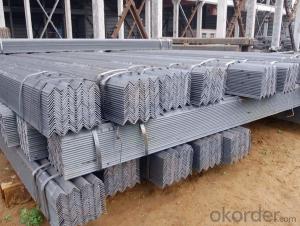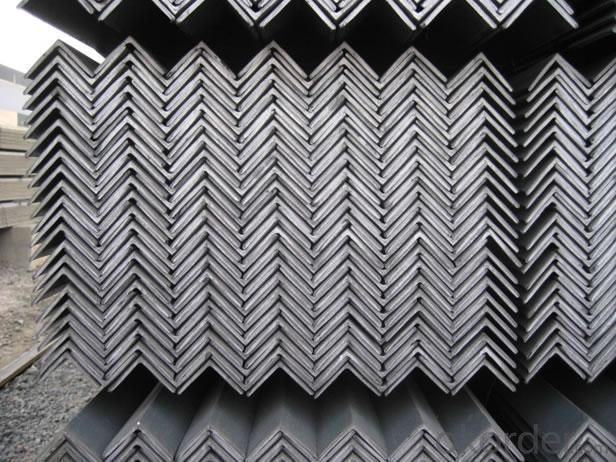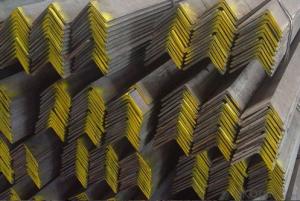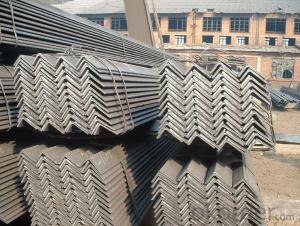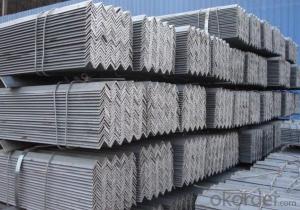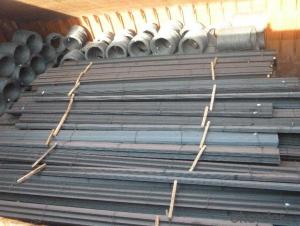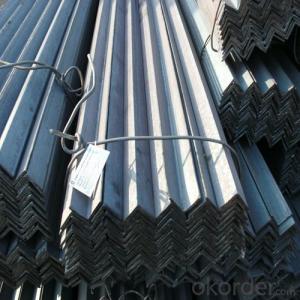Equal Angle Steel and Unequal Angle Steel Hot Rolled
- Loading Port:
- Tianjin
- Payment Terms:
- TT OR LC
- Min Order Qty:
- 25 m.t.
- Supply Capability:
- 20000000 m.t./month
OKorder Service Pledge
OKorder Financial Service
You Might Also Like
Product Description:
OKorder is offering high quality Hot Rolled Steel I-Beams at great prices with worldwide shipping. Our supplier is a world-class manufacturer of steel, with our products utilized the world over. OKorder annually supplies products to European, North American and Asian markets. We provide quotations within 24 hours of receiving an inquiry and guarantee competitive prices.
Product Applications:
According to the needs of different structures, Angle can compose to different force support component, and also can be the connections between components. It is widely used in various building structures and engineering structures such as roof beams, bridges, transmission towers, hoisting machinery and transport machinery, ships, industrial furnaces, reaction tower, container frame and warehouse etc
Product Advantages:
OKorder's Steel I-Beams are durable, strong, and resist corrosion.
Main Product Features:
· Premium quality
· Prompt delivery & seaworthy packing (30 days after receiving deposit)
· Corrosion resistance
· Can be recycled and reused
· Mill test certification
· Professional Service
· Competitive pricing
Product Specifications:
Manufacture: Hot rolled
Grade: Q195 – 235
Certificates: ISO, SGS, BV, CIQ
Length: 6m – 12m, as per customer request
Packaging: Export packing, nude packing, bundled
Sizes: 25mm-250mm | ||||||||||||
a*t | ||||||||||||
25*2.5-4.0 | 70*6.0-9.0 | 130*9.0-15 | ||||||||||
30*2.5-6.6 | 75*6.0-9.0 | 140*10-14 | ||||||||||
36*3.0-5.0 | 80*5.0-10 | 150*10-20 | ||||||||||
38*2.3-6.0 | 90*7.0-10 | 160*10-16 | ||||||||||
40*3.0-5.0 | 100*6.0-12 | 175*12-15 | ||||||||||
45*4.0-6.0 | 110*8.0-10 | 180*12-18 | ||||||||||
50*4.0-6.0 | 120*6.0-15 | 200*14-25 | ||||||||||
60*4.0-8.0 | 125*8.0-14 | 250*25 | ||||||||||
FAQ:
Q1: Why buy Materials & Equipment from OKorder.com?
A1: All products offered byOKorder.com are carefully selected from China's most reliable manufacturing enterprises. Through its ISO certifications, OKorder.com adheres to the highest standards and a commitment to supply chain safety and customer satisfaction.
Q2: How do we guarantee the quality of our products?
A2: We have established an advanced quality management system which conducts strict quality tests at every step, from raw materials to the final product. At the same time, we provide extensive follow-up service assurances as required.
Q3: How soon can we receive the product after purchase?
A3: Within three days of placing an order, we will begin production. The specific shipping date is dependent upon international and government factors, but is typically 7 to 10 workdays.
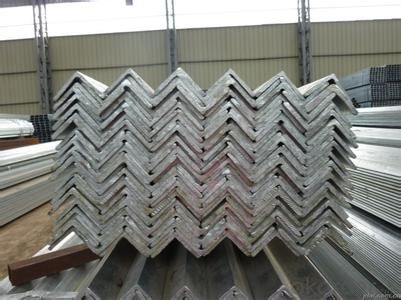
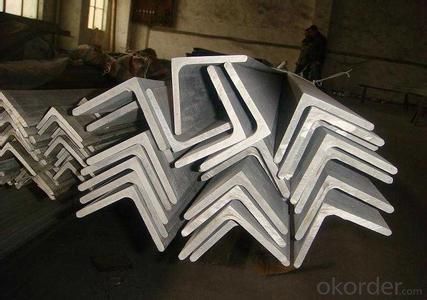
- Q: How do you calculate the strength of a steel angle?
- To calculate the strength of a steel angle, several factors need to be considered. The key parameters include the dimensions of the angle, the material properties of the steel, and the applied load or force. First, the dimensions of the angle must be determined. This includes measuring the length of both legs and the thickness of the angle. These measurements are essential for calculating the area moment of inertia, which is a crucial factor in determining the strength of the angle. Next, the material properties of the steel angle need to be known. This includes the yield strength, ultimate tensile strength, and the modulus of elasticity. These properties can be obtained from material specifications or testing. Once the dimensions and material properties are known, the strength of the steel angle can be calculated using various formulas and equations. One common approach is to calculate the section modulus, which is a measure of the resistance of the angle to bending. The section modulus can be calculated using the formula Z = (b × h^2)/6, where b is the thickness of the angle and h is the distance between the centroid of the angle to the outer edge. The strength of the angle can then be determined by comparing the applied load or force to the calculated section modulus. If the applied load is within the limits of the section modulus, the angle is considered to be structurally sound. However, if the applied load exceeds the section modulus, there is a risk of failure. It is important to note that the calculations for the strength of a steel angle are based on assumptions and ideal conditions. In practice, factors such as material imperfections, fabrication processes, and load distribution can affect the actual strength of the angle. Therefore, it is recommended to consult structural engineers or reference design codes to ensure accurate calculations and safe design.
- Q: What are the different surface finishes available for painted steel angles?
- Painted steel angles offer a range of surface finishes to meet aesthetic and functional needs. 1. Achieving a smooth finish involves evenly applying a coat of paint and then curing it for durability. 2. Textured finishes create a rougher surface with patterns or textures, achieved through techniques like sandblasting or textured paint. These finishes enhance grip and reduce slipperiness in applications requiring traction. 3. Matte finishes have low sheen or gloss levels, resulting in non-reflective surfaces. This option is ideal for applications desiring a subdued appearance. 4. On the other hand, glossy finishes have high sheen or gloss levels, creating reflective and shiny surfaces. They provide a polished and visually appealing look to painted steel angles. 5. Powder-coated finishes are popular for their durability. This method involves coating the steel angle with a dry powder, which is then cured under heat to form a protective layer. Powder-coated finishes offer excellent resistance to scratches, chemicals, and UV rays. 6. Galvanized finishes involve applying a layer of zinc to the steel surface, providing corrosion resistance. While typically not painted, galvanized steel angles can be painted over if desired, allowing for various color options. In summary, painted steel angles offer a variety of finishes including smooth, textured, matte, glossy, powder-coated, and galvanized. The choice depends on the intended use, desired appearance, and required durability for the application.
- Q: What are the different methods of surface finishing for steel angles?
- Steel angles can be finished using various methods, each with its own advantages and considerations. Painting, galvanizing, powder coating, and shot blasting are the most commonly used methods. When it comes to surface finishing steel angles, painting is a popular choice. It not only protects against corrosion but also adds an appealing look. Typically, the angle is cleaned and primed before multiple coats of paint are applied. This method allows for a wide range of colors and easy touch-ups in case of damage. Galvanizing, on the other hand, involves coating the steel angle with zinc to safeguard it from corrosion. This method is particularly effective in harsh environments where moisture or chemicals may be present. The most common technique is hot-dip galvanizing, wherein the angle is immersed in molten zinc. This creates a durable finish that requires minimal maintenance. Another widely used method is powder coating, which entails applying a dry powder to the angle and then curing it with heat. This forms a protective layer that offers excellent durability and resistance to corrosion, chemicals, and UV rays. Powder coating also provides a smooth and consistent finish, with a wide array of color options. For a mechanical surface finishing approach, shot blasting is employed. This method involves blasting the steel angle with high-speed abrasive particles to remove rust, mill scale, or other contaminants. It results in a clean and smooth finish while creating a rough texture that enhances paint adhesion. Shot blasting is often used as a pre-treatment before painting or powder coating. When selecting a surface finishing method for steel angles, it is crucial to consider the specific requirements of their application. Factors such as the environment, expected lifespan, aesthetic preferences, and budget should all be taken into account. Seeking guidance from professionals or the steel manufacturer can help determine the most suitable surface finishing method for steel angles in a given situation.
- Q: Can steel angles be used in mezzanine construction?
- Yes, steel angles can be used in mezzanine construction. Steel angles are often used as structural supports in mezzanine construction due to their strength and versatility. They can be used to create the framework and provide stability for mezzanine floors, making them a popular choice in this type of construction.
- Q: How do steel angles perform in extreme weather conditions?
- Steel angles are highly durable and resistant to extreme weather conditions. They can withstand high winds, heavy rains, and temperature fluctuations without losing their structural integrity. Their strength and stability make them an excellent choice for construction projects in areas prone to hurricanes, tornadoes, or harsh climates.
- Q: Are steel angles resistant to corrosion?
- Generally, steel angles exhibit resistance to corrosion. Typically, steel angles are manufactured from carbon steel or stainless steel, both of which possess inherent properties that resist corrosion. Carbon steel angles develop a protective layer of iron oxide, commonly known as rust, when exposed to oxygen and moisture. This rust layer acts as a barrier, preventing further corrosion of the underlying metal. Conversely, stainless steel angles contain at least 10.5% chromium, which results in the formation of a thin, transparent oxide layer on the surface. This oxide layer, referred to as a passive film, offers exceptional corrosion resistance, making stainless steel angles highly resistant to rust and other forms of corrosion. Nevertheless, it is essential to acknowledge that steel angles can still corrode under specific conditions, such as prolonged exposure to high levels of moisture or corrosive chemicals. To enhance the corrosion resistance and prolong the lifespan of steel angles, regular maintenance and proper cleaning are imperative.
- Q: Can steel angles be used for support structures in telecommunications installations?
- Yes, steel angles can be used for support structures in telecommunications installations. Steel angles provide strength, stability, and durability, making them suitable for supporting heavy equipment such as antennas, cables, and other telecommunications infrastructure.
- Q: Are steel angles fire-resistant?
- Yes, steel angles are fire-resistant to a certain extent. Steel is a non-combustible material, meaning it does not burn or contribute fuel to a fire. It has a high melting point, usually around 1370°C (2500°F), which allows it to maintain its structural integrity even under high temperatures. However, it is important to note that while steel itself is fire-resistant, the fire resistance of a structure or component depends on various factors such as the design, size, and configuration of the steel angles, as well as the fire protection measures implemented. Fire protection methods like fire-resistant coatings, fireproofing materials, or fire-resistant insulation can be applied to steel angles to enhance their fire resistance. These additional fire protection measures can provide a certain level of insulation, delaying the transfer of heat to the steel and extending the time it takes for the steel to reach its critical temperature. This allows occupants more time to evacuate the building and firefighters more time to control the fire. In summary, steel angles are inherently fire-resistant due to the properties of steel, but their fire resistance can be further enhanced by implementing appropriate fire protection measures.
- Q: How do you calculate the torsional strength of a steel angle?
- In order to calculate the torsional strength of a steel angle, several factors must be considered. First and foremost, it is crucial to determine the moment of inertia of the steel angle's cross-section. This can be achieved by utilizing the formula for the moment of inertia of a rectangular shape, namely (b * h^3)/12. Here, b represents the base width and h stands for the angle's height. Once the moment of inertia is established, it becomes possible to calculate the maximum shear stress using the equation T = (M * c)/I. In this formula, T signifies the torsional strength, M denotes the applied torque, c represents the distance from the centroid of the angle to the outermost fiber, and I symbolizes the moment of inertia. Determining the maximum allowable shear stress for the steel angle is achievable by taking into account the material properties of the steel. This value can be retrieved from engineering handbooks or specifications. Lastly, the torsional strength of the steel angle can be calculated by multiplying the maximum allowable shear stress by the moment of inertia of the angle. It is important to note that this calculation assumes the steel angle is only subjected to pure torsion, without any bending or additional external loads. If the angle is exposed to combined loads, more intricate calculations may be necessary to determine the torsional strength.
- Q: Can steel angles be used in bridges or elevated walkways?
- Bridges and elevated walkways can indeed utilize steel angles. Construction projects often employ steel angles because of their strength and versatility. These angles offer structural support and stability, making them perfect for applications like bridges and elevated walkways. By utilizing steel angles, one can establish a framework and support system that guarantees durability and safety for these structures. Furthermore, the ease of welding or bolting steel angles together enables efficient installation and maintenance. In conclusion, the construction of bridges and elevated walkways frequently leans towards steel angles due to their strength, dependability, and user-friendly nature.
Send your message to us
Equal Angle Steel and Unequal Angle Steel Hot Rolled
- Loading Port:
- Tianjin
- Payment Terms:
- TT OR LC
- Min Order Qty:
- 25 m.t.
- Supply Capability:
- 20000000 m.t./month
OKorder Service Pledge
OKorder Financial Service
Similar products
Hot products
Hot Searches
Related keywords
